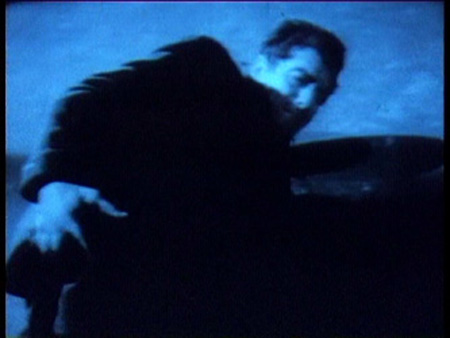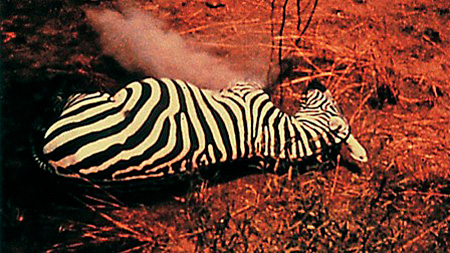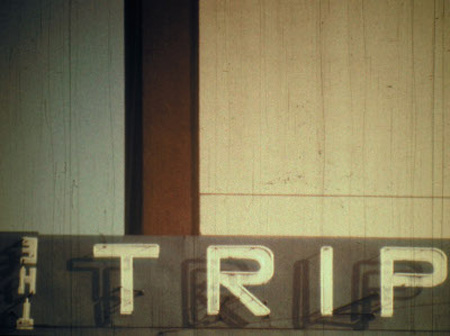Selection of Short Works
The exuberant, irreverent and surprising films of Chris Langdon have recently made a welcome return to the screen after many years out of circulation. A student of Pat O’Neill, Robert Nelson, and John Baldessari, Langdon was incredibly prolific, producing a large body of work in painting, sculpture, film, photography, and graphics. Her legendary film work, created between 1972 and ’76, is often a brash and funny mix of the so-called high and low. Never ponderous or needlessly abstruse, Langdon’s films are direct, formally unique, and full of intuitive flair and wild humor; they delight in provoking and challenging not only modes of artmaking but our reception of art and its purported messages. “Chris Langdon is the first punk filmmaker and the most important unknown filmmaker in the history of the Los Angeles avant-garde.” (Thom Andersen)
Kiss of Death

A compact version of Henry Hathaway’s 1947-movie, refilmed during a 1973-television broadcast with a super 8 camera: 4 or 5 frames from each shot, so that the narrative editing strategies of the whole movie become apparent within 4 minutes. Part of K. Wyborny’s 90-minute film Elementary Film History (1974) and of his 25-minute art-gallery installation Histoire du Cinéma (2004) “I’ve always been very interested in the narrative. My cinema has to do with stretching the narrative until it kind of collapses. I care about the structures, about what they do to one’s mind. Maybe this is being analytical. But I analyze the time structures while I proceed in building them. Structure in itself doesn’t interest me. I am interested only in specific ones which then I kind of try to analyze.” (KW)
Unsere Afrikareise

In 1961 Kubelka was hired to document the African Safari of a group of European tourists. Afterwards he hijacked the material and edited it into an analysis of the many layers of violence present in the hunt, the gaze of the hunters and the film itself. The fragmentary and asynchronic montage of images and sounds generates a multitude of connections and associations which, in their turn, evoke a number of metaphorical interpretations. “For me, Afrikareise is, in its own genre, the most intense sound film that exists. Sound and images are in synch like in nature (even if it isn’t about the natural sound of something). The sound becomes the acoustic portrait of the visual action.” (PK)
--- ------ (Aka Short Line Long Line)

“I consider Thom and Malcolm’s film to be groundbreaking in its brilliant demonstration of the power of a rule to construct a film that unifies shots taken at different times and places. And it also noteworthy for the new model of the documentary film that it proposes. In describing his film as a parody of montage, Thom is being too modest, if not deliberately misleading. The brilliance of --- ------ is that it refuses the power of montage as that idea has been conventionally understood, only to rediscover its power in a different form, on a new plane.” (MF)
Ein Bild
“My film takes its material from the situation that people work for four days on an image that is supposed to be published in the centerfold of the Playboy magazine. The naked woman in the centerfold is like a sun with a revolving system around it: Culture, business, living! (You cannot see or film into the sun). One can imagine that people who have to produce an image of such gravitational force have to do it with the same diligence, seriousness, and responsibility, as if they were involved in nuclear fission. Today, printing companies and publishing houses, the advertisement business, hotels and clubs, galaxies of millions of Dollars, a whole commercial cosmos circle around the naked girl in the centerfold of the Playboy magazine; every month, a new girl takes center stage. A single point has no expansion and is invisible. That is what we have filmed.” (HF)
Einleitung zu Arnold Schoenbergs Begleitmusik zu Einer Lichtspielscene
In the scores of his dramas and his operas Arnold Schönberg generally describes in detail how everything should happen on the stage. But in the score of the Accompaniment to a Cinematograph Scene (1929-1930), there are only four words: “Threatening, danger, fear, catastrophe.” The interpretation of Straub and Huillet revolves around the uneasiness that Schönberg felt at the rise of anti-semitism in Germany, which violently burst out during World War II. They quote from a series of letters that Schönberg wrote to Wassily Kandinsky in 1923, as well as a speech by Bertold Brecht in 1935. “For Straub and Huillet, Nazism is a central event. But yet, in their films they never use images taken inside of Nazism. Why ? Maybe because they believe that artists’ responsibility is to create their own image, daring and contemporary, of their anti-Nazism rather than conduct a so-called critical and distanced montage of images taken by Nazi cameramen”. (SD).